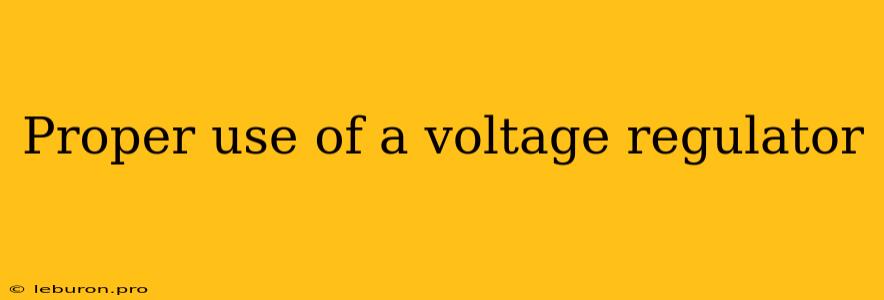The proper use of a voltage regulator is crucial for ensuring the safe and reliable operation of electronic circuits. Voltage regulators are essential components that maintain a constant output voltage despite fluctuations in the input voltage or load current. This article will delve into the intricacies of voltage regulators, exploring their types, applications, and the best practices for their implementation. Understanding these concepts will empower you to select and utilize voltage regulators effectively, optimizing the performance and longevity of your electronic systems.
Types of Voltage Regulators
Voltage regulators can be broadly classified into two main categories: linear regulators and switching regulators. Each type possesses distinct characteristics and advantages depending on the application.
Linear Regulators
Linear regulators operate by dissipating excess voltage as heat, using a series pass transistor to control the output voltage. They are typically simpler to implement and offer low noise and ripple. However, their efficiency is limited due to the power loss in the pass transistor.
Advantages:
- Simplicity: Linear regulators often have a simpler design, making them easier to understand and implement.
- Low noise: Linear regulators typically exhibit low noise and ripple, making them suitable for sensitive applications.
- Wide availability: They are widely available and cost-effective, making them a popular choice for many applications.
Disadvantages:
- Low efficiency: Linear regulators can have relatively low efficiency, especially when the input voltage is significantly higher than the output voltage.
- Heat dissipation: They generate significant heat, requiring proper heat sinks for dissipation.
- Limited output current: Linear regulators often have limited output current capabilities.
Switching Regulators
Switching regulators employ switching elements, such as transistors, to control the output voltage by rapidly switching between on and off states. This approach allows for higher efficiency compared to linear regulators, as power loss is minimized.
Advantages:
- High efficiency: Switching regulators offer higher efficiency, especially at higher input voltage differences.
- Higher output current: They can handle larger output currents than linear regulators.
- Compact size: Switching regulators can be more compact than linear regulators.
Disadvantages:
- More complex design: Switching regulators are generally more complex to design and implement.
- Potential noise and ripple: Switching regulators can introduce noise and ripple into the output voltage, requiring careful filtering.
- Higher cost: Switching regulators tend to be more expensive than linear regulators.
Selecting the Right Voltage Regulator
The selection of a voltage regulator depends on several factors, including the required output voltage, output current, input voltage range, efficiency requirements, and noise sensitivity.
- Output voltage: The desired output voltage determines the regulator's setpoint.
- Output current: The required output current should be within the regulator's maximum rating.
- Input voltage range: The regulator must be able to handle the expected input voltage variations.
- Efficiency: The efficiency of the regulator is critical, especially for power-sensitive applications.
- Noise sensitivity: The noise and ripple characteristics of the regulator should be considered for sensitive circuits.
Proper Use of Voltage Regulators
The proper use of a voltage regulator is essential for optimal performance and reliability. Here are some key considerations:
Input Voltage Considerations
- Input voltage range: Ensure the input voltage remains within the specified range of the chosen regulator. Exceeding the maximum input voltage can damage the regulator.
- Input voltage filtering: Filtering the input voltage using capacitors and inductors can reduce noise and ripple, improving the regulator's performance.
Output Voltage Considerations
- Output voltage accuracy: The output voltage accuracy of the regulator can affect the circuit's functionality. Choose a regulator with the desired level of accuracy.
- Output voltage ripple: The output voltage ripple can introduce noise into the circuit. Minimize ripple through proper filtering and regulator selection.
Output Current Considerations
- Output current rating: Ensure the regulator's maximum output current rating is sufficient for the load requirements. Overloading the regulator can lead to overheating and failure.
- Current limiting: Some regulators have built-in current limiting features to protect against excessive load currents.
Thermal Considerations
- Heat dissipation: Voltage regulators generate heat, especially linear regulators. Adequate heat dissipation is crucial to prevent overheating. Utilize heat sinks or other cooling solutions as needed.
- Thermal shutdown: Some regulators have thermal shutdown mechanisms to protect against overheating. These mechanisms typically shut down the regulator temporarily when a critical temperature is reached.
Common Voltage Regulator Applications
Voltage regulators find numerous applications across various electronic systems, including:
- Power supplies: Regulators are essential components in power supplies, ensuring a stable output voltage for powering electronic devices.
- Battery chargers: Regulators play a vital role in battery chargers, controlling the charging voltage to prevent overcharging.
- Microcontroller circuits: Regulators are frequently used in microcontroller circuits to provide a clean and stable voltage for operation.
- Automotive electronics: Regulators are crucial in automotive applications, supplying a reliable voltage to various electronic components.
Conclusion
The proper use of a voltage regulator is paramount in ensuring the reliable and safe operation of electronic circuits. Understanding the different types of voltage regulators, their characteristics, and best practices for implementation is crucial for engineers and hobbyists alike. By selecting the right regulator and implementing it correctly, you can create robust and efficient electronic systems, enhancing performance and prolonging component life.
